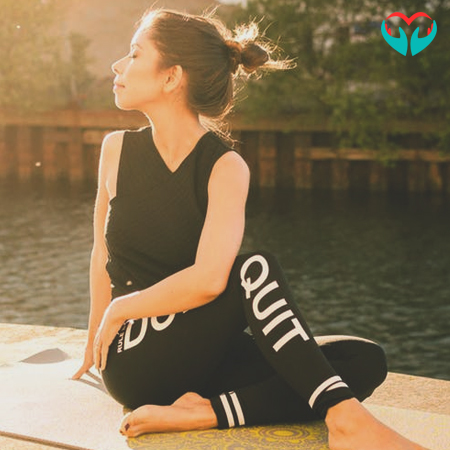1. Reclining pigeon pose
Pigeon pose is a common yoga pose. It works to open the hips. There are multiple versions of this stretch. The first is a starting version known as the reclining pigeon pose. If you are just starting your treatment, you should try the reclining pose first.
While on your back, bring your right leg up to a right angle. Clasp both hands behind the thigh, locking your fingers.
Lift your left leg and place your right ankle on top of the left knee.
Hold the position for a moment. This helps stretch the tiny piriformis muscle, which sometimes becomes inflamed and presses against the sciatic nerve, causing pain.
Do the same exercise with the other leg.
Once you can do the reclining version without pain, work with your physical therapist on the sitting and forward versions of pigeon pose.
2. Sitting pigeon pose
Sit on the floor with your legs stretched out straight in front of you.
Bend your right leg, putting your right ankle on top of the left knee.
Lean forward and allow your upper body to reach toward your thigh.
Hold for 15 to 30 seconds. This stretches the glutes and lower back.
Repeat on the other side.
3. Forward pigeon pose
Kneel on the floor on all fours.
Pick up your right leg and move it forward on the ground in front of your body. Your lower leg should be on the ground, horizontal to the body. Your right foot should be in front of your right knee while your right knee stays to the right.
Stretch the left leg out all the way behind you on the floor, with the top of the foot on the ground and toes pointing back.
Shift your body weight gradually from your arms to your legs so that your legs are supporting your weight. Sit up straight with your hands on either side of your legs.
Take a deep breath. While exhaling, lean your upper body forward over your front leg. Support your weight with your arms as much as possible.
Repeat on the other side.
4. Knee to opposite shoulder
This simple stretch helps relieve sciatica pain by loosening your gluteal and piriformis muscles, which can become inflamed and press against the sciatic nerve.
Lie on your back with your legs extended and your feet flexed upward.
Bend your right leg and clasp your hands around the knee.
Gently pull your right leg across your body toward your left shoulder. Hold it there for 30 seconds. Remember to pull your knee only as far as it will comfortably go. You should feel a relieving stretch in your muscle, not pain.
Push your knee so your leg returns to its starting position.
Repeat for a total of 3 reps, and then switch legs.
5. Sitting spinal stretch
Sciatica pain is triggered when vertebrae in the spine compress. This stretch helps create space in the spine to relieve pressure on the sciatic nerve.
Sit on the ground with your legs extended straight out with your feet flexed upward.
Bend your right knee and place your foot flat on the floor on the outside of your opposite knee.
Place your left elbow on the outside of your right knee to help you gently turn your body toward the right.
Hold for 30 seconds and repeat three times, then switch sides.
6. Standing hamstring stretch
This stretch can help ease pain and tightness in the hamstring caused by sciatica.
Place your right foot on an elevated surface at or below your hip level. This could be a chair, ottoman, or step on a staircase. Flex your foot so your toes and leg are straight. If your knee tends to hyperextend, keep a slight bend in it.
Bend your body forward slightly toward your foot. The further you go, the deeper the stretch. Do not push so far that you feel pain.
Release the hip of your raised leg downward as opposed to lifting it up. If you need help easing your hip down, loop a yoga strap or long exercise band over your right thigh and under your left foot.
Hold for at least 30 seconds, and then repeat on the other side.



 Contact Us
Contact Us







 Hospitals
Hospitals
 Doctors
Doctors
 Diagnostic
Diagnostic
 Pharmacy
Pharmacy
 Health Tips
Health Tips
 Blog
Blog


















